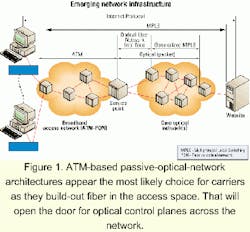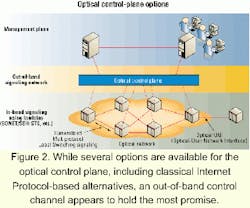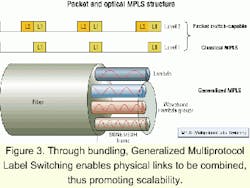Integrated optical control planes
An understanding of control-plane requirements is the key to realizing the next-generation optical network.
JOHN FRYER, NetPlane SystemsAdvances in optical networking, specifically technologies like DWDM, are giving service providers the potential to gain almost unlimited bandwidth and higher reuse of fiber for the economic deployment of profitable new services. But before this potential can be realized, equipment vendors face the challenge of how to provide control-plane intelligence that can enable service providers to create, then rapidly and flexibly provision new high-bandwidth services.
One very promising solution is integrating the powerful hardware capabilities of the data plane with an intelligent control plane through the adaptation of Internet Protocol (IP) routing techniques with optical enhancements to Multiprotocol Label Switching (MPLS), often known as Multiprotocol Lambda Switching. While seen as the key to ushering in next-generation optical networks, this highly sophisticated solution pushes the boundaries of what has been done for a control plane in the telecommunications area.
Before examining this optical control-plane solution, particularly the evolution of control-plane technologies as they apply to classical IP networks and emerging optical networks, it is important to review some of the underlying market dynamics and existing economic hurdles. The most fundamental dynamic is the economics of service-provider requirements.
While optical advances are drastically improving the economics of the core, industry experts agree that less than 20% of the fiber in the ground is actually "lit." Most of that can benefit from new generations of equipment deploying more wavelengths per fiber. Until large amounts of bandwidth can be effectively deployed in the residential market, the demand will not exist to fully exploit the potential of intelligent optical networks. Mass deployment of high-speed broadband access networks, which enable the generation of substantial revenues, will first be necessary to facilitate full-scale adoption of next-generation optical technology.
Attempts to use DSL technology to deploy broadband access networks have been a noticeable failure. The decline in competitive local-exchange carriers attests to this fact. It is clear that copper is becoming limited in its ability to deliver the access speeds required by advanced broadband services. For this reason, the extension of optical technology into the access network is becoming an increasingly interesting proposition.The challenges of the access network, however, are very different from those in the core. Ultimately, each access point is delivered to a single user, so cost becomes a primary factor. In the core, a single fiber leverages many OC-48, OC-192, or Gigabit Ethernet connections, each of which carries multiple users. Upgrading the access network is therefore a costly proposition and requires extensive use of multiplexing to drive the economics.
It's feasible that fiber economically can be laid close to the curb, or a residential neighborhood, with existing copper used for the last segment of the connection. The application of passive optical networking (PON) is viewed as a low-cost option in this area. Other alternatives exist, such as the current extension of the cable-TV networks and the possible deployment of wireless technology.
Of all the alternatives, it seems likely that PON access networks will be favored in the United States and be based on ATM (see Figure 1). ATM is clearly the technology of choice for the regional Bell operating companies' (RBOCs') build-out of broadband access. That will not prevent MPLS from being deployed as an overlay to an ATM-PON network, or using MPLS signaling as an alternative to ATM while still using the underlying ATM cell-based transport mechanism. Initially, however, it is reasonable to expect that MPLS, whether applied to classical IP or optical networking, will operate in core networks and not in the access layers.
Once the broadband build-out occurs, and it is a safe assumption that it will, the interaction of packet (IP) technology and an intelligent optical control plane will be critical to fully realizing the potential of intelligent optical networks. Today, the network focus is on providing better and different services such as quality of service and class of service for IP through traffic engineering and IP-based virtual private networks-applications where MPLS is a key part of the solution.
A sophisticated optical control plane and its ability to be adopted by the service-provider community is becoming a pivotal issue for the evolution of new generations of equipment. A classical IP control plane will always remain, but as the optical layer begins to provide many of the features of routing and signaling currently performed at the packet layer, the importance of current classical techniques may diminish or be subsumed by the optical layer.
During this evolution, it may seem as though IP networking is continuing to utilize a full mesh network and that it has simply "swapped" an underlying ATM infrastructure for one that is optical. If there is no relationship between the IP overlay and the transport layer, as there is with ATM, then the need for a strong IP layer still exists. But if the optical control plane utilizes many of the techniques applied at the IP layer, then there is clearly a synergistic relationship that may lead to long-term optimizations.
The intelligent optical control plane and the interplay between classical IP services are the backdrop for much of the standards-related activity in both the Internet Engineering Task Force (IETF) routing area and Optical Interworking Forum (OIF). In the IETF, this work focuses on adapting existing routing technology, as in the case of open shortest path first (OSPF) and intermediate system to intermediate system (IS-IS), and using the principles of MPLS to create the basis for an optical control plane-that is, a set of Generalized MPLS (GMPLS) standards. This work has been progressing for several months but requires some radical thinking and still has a considerable way to go to reach consensus and standardization.
Many companies are contributing to the standards process, but some have opted to implement proprietary routing and signaling mechanisms based on the concepts of GMPLS to enable the deployment of single-vendor networks. That may represent a market strategy to lock in service-provider customers. Whether such a strategy is viable in the long term will be decided by service providers' willingness to accept proprietary solutions.
Recognizing that not all market segments require participation in a full routing and signaling optical control plane, the OIF is developing the Optical-User Network Interface (O-UNI) specification, which will enable devices to request services from a core optical network. That also addresses the issue of enabling multivendor interworking when the core optical network is a single-vendor solution with proprietary routing and signaling in the control plane.
The optical control plane deals with routing and signaling through the physical layers (PHYs) of a network. The GMPLS standards accommodate the range of distinct attributes particular to optical networking that were not envisioned when the original MPLS standards were developed.
Classical IP makes the assumption that control-plane traffic and data-plane traffic flow together between neighbors. With photonic technology, this assumption is far from guaranteed. It would mean that every optical interface would have to embed a control channel, which would have to be decoded by each device. For purely photonic devices, that would be extremely onerous and may impose severe limitations on SONET/SDH equipment and optical-electrical-optical switches. The solution is to provide the option for an out-of-band control channel (see Figure 2).An out-of-band control channel, which must be bidirectional, introduces the problem of how connectivity is determined between two adjacent neighbors. The discovery mechanisms of an OSPF- or IS-IS-like protocol can no longer be used to determine connectivity, so the need arises for a different protocol that operates more at the PHY to ensure that the data plane is operational. That has been defined in the Link Management Protocol and it has been generalized to provide typical Layer 1 functionality such as fault detection and isolation.
Optical transport represents a number of different technologies ranging from SONET/SDH, including the time-division multiplexing (TDM) structure embedded within its framing, to fibers that carry multiple wavelengths through the use of DWDM technology. These technologies can be layered in a hierarchical fashion, and connections at one layer can be used as a path to establish connections at a higher layer. That in itself is a radical departure from classical IP routing, which assumes a flat underlying Layer 2 transport. This hierarchical structure also has implications for both signaling and routing.
With DWDM technology, many parallel paths will be created at the lambda and SONET/SDH layers of the hierarchy. Traditional IP routing principles dictate that the discovery process operates across each link and that topology information is exchanged across all these links. That can generate substantial amounts of redundant information and have a severe impact on the scalability of the routing protocol. To alleviate this problem, GMPLS introduces the concept of bundling, whereby the physical links are combined into a logical link, which is advertised as a single link, into the routing protocol (see Figure 3).There are additional constraints that must be applied to the optical routing process, particularly when pure photonic devices are used. These devices are generally incapable of changing wavelengths from an input port to an output port. Once a particular wavelength has been used on an interface, the routing and signaling mechanisms must be able to identify that this wavelength is blocked from use by another interface. These types of changes must be incorporated into the Djikstra-type calculations to determine the shortest constrained path.
Perhaps the most obvious difference between classical IP and optical networks is that optical technologies have no concept of IP addresses. The use of IP is an abstraction onto the optical control plane, and the assignment of IP addresses to each interface is an internal management issue. It may not be possible, or desirable, to assign an IP address to each interface, and capabilities do exist to handle both routing and signaling for these "unnumbered" links.
The link bundling, hierarchy, and identification of connected neighbors are primarily routing issues. Unlike classical IP, there is no concept of "hop by hop" forwarding in the optical plane. Paths must be defined through a network prior to sending traffic, which is the equivalent of creating a label-switched path (LSP) with classical MPLS. Optical LSPs by their very nature are "traffic engineered" (TE). At minimum, an optical connection is associated with bandwidth and may have other optical-specific traffic engineering constraints. (These TE extensions are reflected in draft specifications, which extend the capabilities of the classical IP TE extensions.)
GMPLS also specifies changes to the CR-LDP and TE-RSVP signaling protocols for the optical control plane. In addition to creating explicit paths that reflect optical-specific traffic engineering constraints, the definition of a label is also different. For the generalized model, a full 32-bit label is specified that can satisfy lambda-type requirements as well as map SONET/SDH framing structures to identify specific bandwidth allocations. A generic classical IP label uses 32 bits, but only 20 bits actually represent the label; the remainder carry additional information such as time to live. Classical MPLS LSPs are also unidirectional, and protocol changes need to reflect both the typical bidirectionality of optical LSPs and the fact that some optical technologies, such as micro-electromechanical systems (MEMS) tilting mirrors, have a settling time.
The GMPLS specifications allow for labels to be suggested in the downstream (ingress-to-egress) direction so that hardware can be preprogrammed to reduce latency. The potential drawback is that the setup may fail, if the suggested label does not intersect with an available label at the downstream node. That can be much more of a problem in a pure photonic environment where the same wavelength must be used on an end-to-end basis.
Implicit in classical MPLS is the concept that the start and end points of an LSP are the same type of device, in this case, a label edge router. This concept is carried forward into the GMPLS world where LSPs can exist at each level of the hierarchy. The logical rule is that optical LSPs must start and terminate on like devices or at the same level of the hierarchy; an Ethernet LSP must start and terminate on Ethernet-capable devices and a lambda-based LSP must start and terminate on a wavelength-capable device.
As LSPs are established at lower levels of the hierarchy, they form LSPs that can now be used at higher levels. For example, once an LSP has been created over a fiber, lambda-level LSPs can now be established. Once the lambda-level LSPs are established, Ethernet or SONET/SDH LSPs can be overlaid. A lambda-based LSP can span multiple physical devices, which changes the definition of adjacency as it is traditionally understood.
Edge devices for these LSPs at higher levels of the hierarchy need to learn that they can create their own LSPs using these newly created lower-level LSPs. That is done by injecting these forwarding adjacency LSPs into the routing protocols, so that they can be propagated through the network using standard routing procedures.
Flowing over these PHY LSPs are the traditional IP- or packet-switch-capable LSPs. Just as with the optical hierarchy, this interaction between the packet world and optical world-where both are using the same underlying protocol mechanisms-has the potential to offer optimizations in the future. Additionally, there is no reason traditional TDM connections could not be routed using GMPLS principles. There are many challenges in this area, including the structural division within carriers where transport mechanisms are separated from services.
The set of protocols and procedures specified in the GMPLS standards requires a sophisticated control plane to participate in the routing and signaling. Devices that sit at the edge of the network may only want to use the resources without participating in the full routing mechanism. The O-UNI specification is designed for this purpose and is being developed in parallel with the GMPLS mechanisms specified by the IETF.
The GMPLS and O-UNI concepts represent the drive toward an integrated optical control plane. They offer a level of sophistication beyond anything that has been developed for a control plane in the telecommunications area. There still is much work to be done: refining the concepts of the current draft specifications, developing the protocol specifications to deliver the required functionality, and ensuring that all the possible interactions have standard handling procedures. As yet, no thought has been given by the standards bodies to supporting an equivalent of BGP4 for internetwork optical routing.
The GMPLS development process will take time. But it promises a network infrastructure that can support rapid service provisioning and form the underlying mechanism for new service offerings that are fully integrated with existing IP technologies.
John Fryer is vice president of marketing at NetPlane Systems (Dedham, MA). He can be reached at [email protected].




